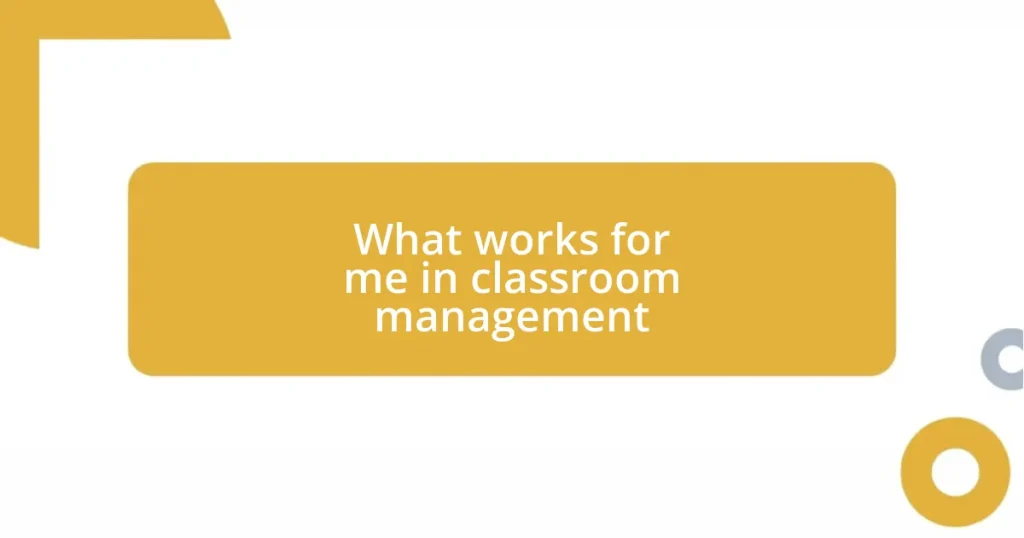Key takeaways:
- Establishing clear expectations fosters a focused and responsible classroom environment, enhancing student engagement.
- Building positive relationships through personal connections and trust encourages students to participate and take risks in learning.
- Utilizing diverse and engaging activities, like hands-on experiments and games, transforms learning into an exciting experience for students.
- Adapting teaching methods to accommodate diverse learners, such as incorporating visual aids and collaborative groups, enhances inclusion and understanding.

Understanding Classroom Management Strategies
Effective classroom management strategies are the backbone of a successful learning environment. I remember my first year of teaching when I underestimated the power of clear expectations. It was an eye-opener to see how much smoother things went once I established specific rules and routines; the clarity gave students a sense of security, which fostered a more focused atmosphere.
Another key aspect is the importance of building relationships with students. I’ve learned that when my students felt valued and understood, they were more engaged and willing to participate. Have you ever noticed how a simple compliment or a listening ear can transform a student’s day? Those little moments really pave the way for open communication and cooperation.
Engagement doesn’t just happen; it requires intentionality. I often struggle with keeping all students interested at the same time, especially during challenging lessons. It’s in those moments that I pull out diverse strategies, like incorporating group work or interactive activities. I wonder, how often do we reflect on our practices to ensure that every student feels included? By continually adapting my methods, I’ve discovered that a flexible approach makes retention and participation soar.

Effective Communication Techniques
Effective communication in the classroom is vital for establishing a positive learning environment. I recall a moment when I was trying to engage my third graders during a history lesson, and I realized that simply presenting facts wasn’t enough. When I started asking open-ended questions and encouraging students to share their thoughts, the room lit up with ideas and conversations. It was enlightening to witness how much they valued being heard.
Here are some techniques I find particularly effective for communication:
- Active Listening: I make it a point to listen attentively when students express their thoughts or concerns. A nod or a simple “I hear you” goes a long way.
- Clear Language: I avoid jargon or complex language. Instead, I opt for simple, clear instructions. This helps ensure that every student understands what’s expected.
- Non-verbal Cues: I pay close attention to body language—both mine and the students’. A smile or an encouraging gesture can create an inviting atmosphere.
- Feedback Loops: After discussions, I always ask for feedback from my students. This helps me adjust my approach and shows them that their opinions matter.
- Storytelling: I often share personal anecdotes related to the lesson. It not only makes the content relatable but also opens the door for students to share their own stories.
When these communication techniques are implemented consistently, the classroom truly becomes a vibrant space for learning.

Setting Clear Expectations
Setting clear expectations is essential in creating a productive classroom atmosphere. I’ve found that when I explicitly outline my rules and the behavior I expect, students respond positively. For example, at the beginning of the school year, I introduced a mini contract that we created together. This not only made them feel involved but also reinforced a sense of responsibility.
In my experience, revisiting these expectations throughout the year can make a huge difference. I remember a time during a group project when things started to get chaotic. I took a few minutes to re-explain our agreed-upon guidelines and it was like flipping a switch. The students refocused and re-engaged, demonstrating how powerful it is to reinforce common goals and behaviors.
Lastly, I’ve learned that setting clear expectations also involves modeling the behavior I want to see. For instance, I often demonstrate how to raise a hand to speak or how to listen respectfully. When they see me practicing what I preach, it creates a culture of mutual respect. Reflecting on these moments makes me appreciate just how interconnected clarity and respect can be in our learning environment.
| Expectation | Outcome |
|---|---|
| Clear Rules | Improved focus and responsibility |
| Regular Check-ins | Refocused engagement and collaboration |
| Modeling Behavior | Culture of respect and mutual understanding |

Building Positive Relationships
Building positive relationships in the classroom is at the heart of effective management. One of my most memorable experiences was when I noticed a student sitting alone during lunch. I took the initiative to invite them to join our group and learned they had a passion for drawing. The simple act of including them transformed their demeanor, highlighting how meaningful connections can foster a sense of belonging and enhance classroom dynamics.
I’ve also found that making an effort to remember personal details about my students can create stronger bonds. For example, when I asked a student about their soccer game on Monday, their face lit up with excitement. It’s amazing how these little touchpoints can validate their interests and make them feel valued. Isn’t it fascinating how such simple gestures can open doors to deeper connections?
Trust has a significant role in building these relationships, too. I recall a time when I encouraged a student to share their struggles with a project. They were hesitant at first, but I assured them my classroom was a safe space for vulnerability. After they opened up, the relief on their face was palpable. It reinforced my belief that when students trust their teacher, they are far more likely to take risks in their learning. How often do we forget that strong relationships can create an environment where students feel brave enough to explore their potential?

Implementing Consistent Routines
Implementing consistent routines can transform the classroom experience in ways I never anticipated. I vividly recall the first week of introducing a daily check-in ritual every morning, where students shared one good thing that happened to them. It not only set a positive tone for the day but also helped my students connect and engage with each other on a personal level. Isn’t it interesting how such a simple practice can lift spirits and create a sense of community?
As the weeks progressed, I noticed that when we followed our established routines—like transitioning from one activity to the next with a countdown or signal—students felt more at ease. For example, during our reading time, I would softly play classical music as a cue to silence everyone and prepare for a focused session. The first time I tried this, I felt nervous about how they’d respond, but to my delight, they actually began to settle in faster. There’s a real magic in knowing what to expect, isn’t there?
Throughout my teaching journey, I’ve learned that flexibility within routines is just as essential as consistency. I remember an afternoon where an unexpected fire drill interrupted our schedule. Instead of allowing the disruption to unsettle us, I quickly reminded the students of our routine for emergencies. Their calm response impressed me; it showed how those practiced routines not only fostered structure but also equipped them to handle surprises. How great is it to see students thrive, even when faced with the unexpected?

Utilizing Engaging Activities
Engaging activities have become a cornerstone of my classroom management strategy. I fondly remember one science lesson where I turned a standard lecture into a hands-on experiment. The students were divided into small groups to build simple circuits using batteries and bulbs. The excitement in the room was palpable as they laughed and experimented, connecting theory with practice. Don’t you find it rewarding to see students so actively involved in their learning?
I’ve also discovered that incorporating games into lessons can significantly increase student motivation. For instance, I once introduced a math jeopardy game, and the competitive spirit ignited a level of enthusiasm I hadn’t seen in my students before. It felt like they were not just answering questions; they were genuinely invested in the outcome. How incredible is that moment when students transition from viewing learning as a chore to treating it as an exciting challenge?
Moreover, I try to tailor these activities to the diverse interests of my students. I recall providing a choice board for a book report project, allowing students to choose how they wanted to present their understanding—be it a digital poster, a skit, or even a video. The range of creativity that emerged surprised me; some students who typically struggled to engage became the stars of the show. Isn’t it fascinating how granting choices can lead to remarkable transformations in student participation?

Adapting Approaches for Diverse Learners
Understanding the unique needs of diverse learners in my classroom has been a game-changer. I vividly recall one student, Sarah, who thrived when I started incorporating visual aids into my lessons. By using diagrams and colorful charts, I could see her eyes light up. It’s heartwarming to witness how simple adjustments can help students feel included, isn’t it?
Another approach I’ve found effective is the use of collaborative learning. For instance, during a literature unit, I formed small groups that mixed different reading levels. Watching students work together, each contributing their strengths, was truly fulfilling. They learned not only from the text but also from each other. Have you ever experienced that moment when a student explains a concept to their peers? It’s so inspiring to see knowledge blossom in such organic ways.
I also embrace the power of flexibility in my teaching methods. Recently, I had a lesson planned for a math topic that usually caused frustration among my students. Instead of sticking rigidly to my plan, I pivoted and turned it into a hands-on activity involving manipulatives. The relief and excitement on their faces were unmistakable. Isn’t it incredible how adapting your approach can transform apprehension into enthusiasm? It’s moments like these that remind me why I love teaching.















